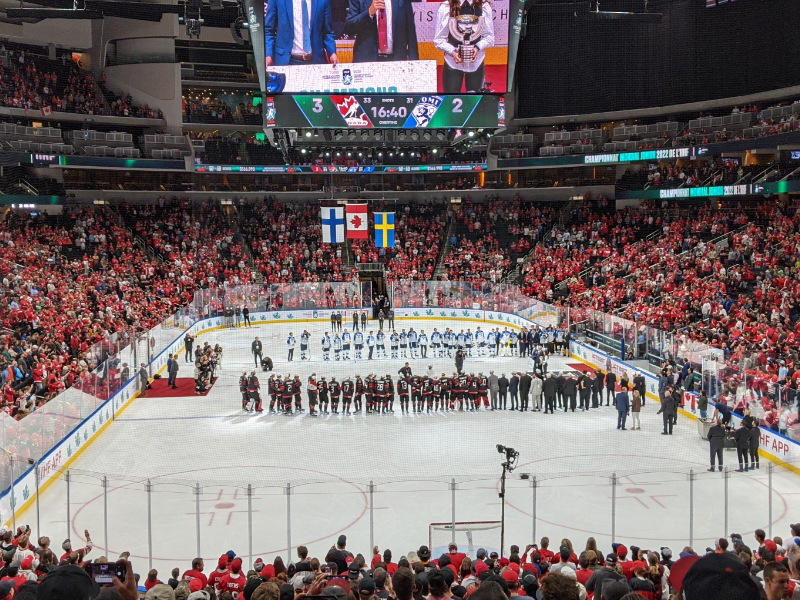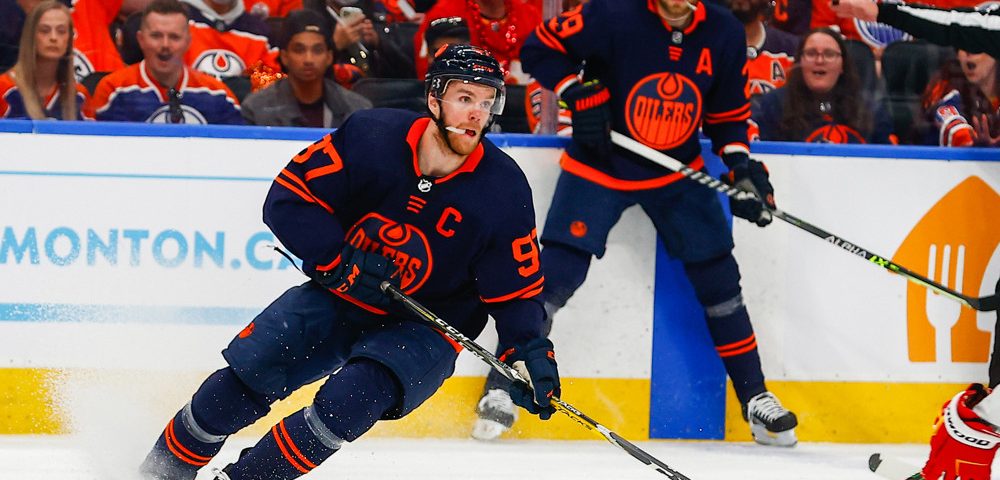
Canada Announces 2023 World Junior Roster
December 15, 2022
Call Outs, Standouts, and Shout Outs: Predators Beat Oilers 4-3 in Overtime
December 20, 2022McDavid Lost Control

EDMONTON, AB - MAY 22: Edmonton Oilers Center Connor McDavid (97) and Edmonton Oilers Center Leon Draisaitl (29) in power play action in the first period during the Edmonton Oilers versus the Calgary Flames in the Stanley Cup playoffs round 2, game 3 on May 22, 2022 at Rogers Place in Edmonton, AB. (Photo by Curtis Comeau/Icon Sportswire)
December 16, 2022 by Ryan Lotsberg
Connor McDavid lost control in a few ways on Thursday night.
Darnell Nurse committed a turnover to Vladimir Tarasenko late in the game. McDavid was able to recover that turnover, but Jordan Kyrou stripped him of the puck behind the net and found Tarasenko in the slot for the game tying goal with twenty seconds left.
Leon Draisaitl thought he had scored the game winning goal in overtime, but the goal was disallowed because McDavid was ruled to have been off-side on the play. By rule, he did not have control of the puck as he crossed the blue line. The St. Louis Blues went on to win in a shootout. That prompted something of a rant from McDavid after the game, the final way that he lost control:
“… we kind of got burned on a call in the playoffs over a similar type of situation, you don’t know if it’s off-side or on-side; but you know, the league’s got to clarify some of these rules. You know, what’s a kick, what’s off-side, what’s goalie interference. It kind of depends on the night, I guess.”
Alright, “losing control” is a stretch for his post-game rant. He’s rarely critical, but he remained poised and didn’t come across as angry while making his comments. McDavid has a point though. I personally have no idea what will happen during most reviews because of the general lack of consistency that the NHL has shown in making these rulings.

McDavid referenced the Cale Makar off-side goal in game one of the Western Conference Finals last year, but his zone entry on Thursday night was different. He pushed the puck back slightly behind him as he crossed the blue line. Both of his skates crossed the blue line before the puck did. It was ruled off-side because the puck was not touching his blade when it crossed the blue line. The call was correct.
However, look at this video from March 15, 2016. Evgeni Kuznetsov made a move similar to the one McDavid made where he pushed the puck slightly behind him and then crossed the blue line. Both of Kuznetsov’s skates crossed the blue line before the puck did, and the puck was not touching his blade when it crossed the blue line. This play was ruled on-side! It’s an old example, but the two plays at the blue line were exactly the same, and the rulings were different. The call on the Kuznetsov play was clearly a mistake. McDavid is right to be upset about the inconsistency on all sorts of rulings.
A referee or someone in the war room in Toronto would likely respond to McDavid’s comments by saying something like “The rule is written in the rulebook, so you can’t say it isn’t clear”. Let’s examine the way the off-side rule is written.
This quote is taken from Rule 83.1 on off-side in the NHL rulebook:
“A player actually controlling the puck who shall cross the line ahead of the puck shall not be considered ‘off-side,’ provided he had possession and control of the puck prior to his skates crossing the leading edge of the blue line.”
“Possession” and “control” are the two words that need to be properly defined. The glossary of terms in the rulebook defines the terms in this way:
“Possession of the Puck: The last player to physically touch the puck with his stick or body shall be considered in possession of the puck.”
“Control of the Puck: The act of propelling the puck with the stick, hand or feet. Control of the puck is not lost when contact with the puck is made by an opponent, the boards or the net, provided the player in control of the puck continues propelling the puck.”
Their definition of possession is fairly clear. The last person on the ice to have touched the puck has possession of the puck.
Related: What Lies Ahead After Puljujarvi’s Comments
The definition of control is much less clear. “The act of propelling the puck with the stick, hand or feet” is somewhat clear, but it does not clearly state that the puck must be touching the stick, hand, or foot for a player to have control of the puck.
There is a note in the definition of possession:
“(NOTE 1) A player can have possession of the puck without control, but he cannot have control of the puck without possession.”
The first part of the sentence makes sense based on their definition of possession. The second part is confusing though. “Control of the puck is not lost when contact with the puck is made by an opponent, the boards, or the net, provided the player continues propelling the puck”. A player can pin the puck against the boards or against the net and have control, which makes sense because the puck would still be touching the blade in either instance.
This statement implies that a player can bank the puck off the boards or the net and still have control of the puck because it says nothing about the puck having to be in contact with the stick, hand or foot to have control. The puck does not touch the stick when it’s sliding on the ice en route to the boards or the net when a player banks it off either thing, so that tells me that the puck doesn’t have to be touching the stick for a player to have control of the puck.
What about when contact is made by an opponent? That doesn’t make any sense because if an opponent touches the puck, then that player has possession of the puck. You can’t have control without possession, so how can a player have control of the puck if an opponent makes contact with it thus gaining possession? The only way it could make any semblance of sense is if a player was to pin the puck against an opponent, which would be stupid play. In that scenario, both players would be touching the puck, so both players would have possession. I would argue that neither player has control in that scenario.

The NHL could rid itself of a lot of frustration and grief by simply rewriting the definition of control. Makar knew exactly what he was doing when he pushed the puck across the blue line and didn’t touch it until his teammate cleared the zone. McDavid and Kuznetsov did not fumble the puck. They pushed the puck along the ice in an intentional manner. All three players were in control of the puck in my estimation because they did what they wanted to do with it. I would change the definition of “Controlling the Puck” to read like this:
“Control of the Puck: The act of propelling the puck with the stick, hand or feet. The puck does not need to be in contact with the player’s stick, hand, or foot for a player to have control of the puck if the player has imparted force on the puck in an intentional manner, such as while stickhandling. A player loses control of the puck once another player on the ice makes contact with the puck, thus gaining possession of the puck.”
This is a much clearer definition of control that uses some common sense. It’s ridiculous that a player can be deemed to not have control of the puck while stickhandling. Stickhandling is a skill that requires the puck to not always be in contact with the stick, but it’s a skill that requires control of the puck. By my rewritten definition of control, Makar’s goal would have been off-side because he would’ve had control of the puck while his teammate was in an off-side position.
I would also ditch the part of the off-side rule where a player can enter the zone before the puck if the player has possession and control for the sake of clarity. The off-side rule states that “[p]layers of the attacking team must not precede the puck into the attacking zone”. That’s it. Cut and dry. It would be as simple as removing the paragraph that talks about a player entering the zone before the puck. That would mean that the McDavid and Kuznetsov zone entries would have been off-side because they entered the zone before the puck did.
McDavid also talked about how his team should never have put itself in that situation, which is also true. They lost because of poor puck management at the end of the game and because they couldn’t score in the shootout. Looking in the mirror first before blaming others is the best way to approach these situations. McDavid was clearly frustrated that his zone entry was ruled off-side, but his point was that there needs to be consistency from the referees and clarity in the rules, which is a totally valid point.

